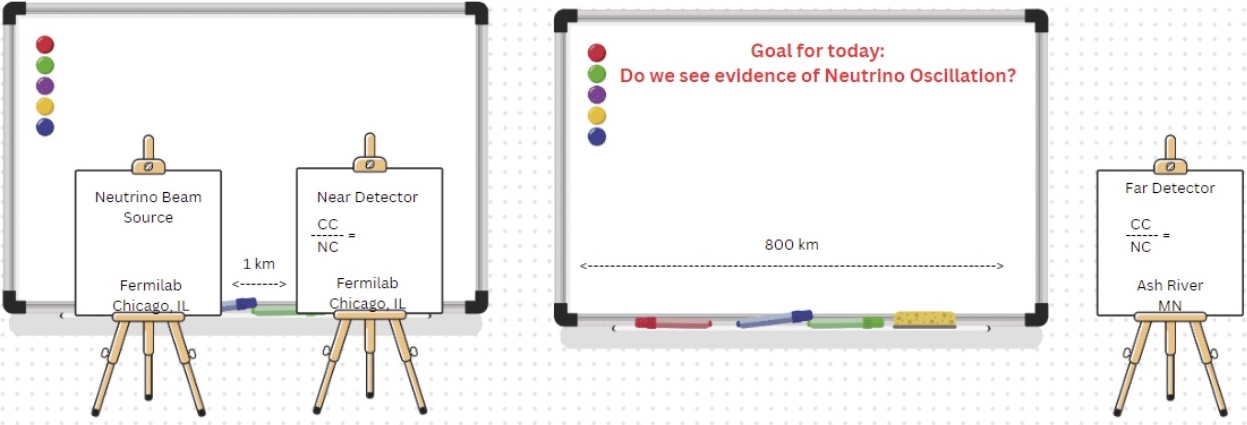NOvA Neutrino Measurement 2025
Navigation
- Screencasts
- Preparation
- Physical space set-up
- The agenda outline
- Opening activities
- Mentor presentation
- NOvA Overview and Analysis, Part 1 - Far Detector
- NOvA Analysis, Part 2 - Near Detector and Conclusions
- Discussion of Results - Understanding the Results
- Videoconference (optional)
- Data and data analysis tools
Notes:
This page is meant to guide masterclass leads: physicists, teachers, tutors, etc. Students participating in the NOvA masterclass can access data and tools through the Student Start Page.
Remote Masterclass? Students need more prep? Try NOvA Instructional Screencasts, coming soon!
Preparation Before Masterclass Day
Before the masterclass, mentors, tutors, and teachers should:
- Schedule and participate in an online Orientation.
- Create an agenda for the masterclass day.
- **Check with participating teachers and students to ensure they have access to Google Colaboratory**. Some schools block this feature; school IT staff may be able to unblock this feature. A personal Google account should grant access to Google Colab. Students may also partner up with another student who has access to Colab, or they may utilize the alternative Binder site.
- Prepare or invite a speaker to give a presentation on particle physics and/or neutrino experiments.
- Try out a Python Coding exercise, such as the ones linked below:
- Remind participants that they will need a laptop (or a Chromebook or a similar device) during the event.
- Check that the space that will be used for the masterclass has appropriate internet access available.
- Review this entire page, which contains information on the NOvA Measurement and how to understand the results.
- Print out cheat sheet - one per student.
Physical Space Setup
The below assumes a classroom-like space, with a large front white board. Similar setup could also be achieved with two or three free-standing easel poster boards.
- Provide information for participant internet connection (Wi-Fi information, etc.)
- Provide a link, preferably shortened, to the agenda page for the day. This is where students will access their data and coding notebooks.
- Post the following in the room for reference throughout NOvA masterclass:
- From left to right, write "Neutrino Beam Source", "Near Detector", and "Far Detector" on a whiteboard or poster paper that will serve of the relative layout of these three important components of the NOvA experiment. These posters will also serve as a locations to post CC/NC ratios at each detector for comparison. It is recommended to write the overall NOvA masterclass goal on the board or poster paper as well. Refer to the diagram below for an example of this set-up.:

The Agenda (Click here for an example agenda.)
Opening Activities: (~30-60 min) - optional
- Registration: please have students sign in on a registration sheet with name, school, and teacher.
- Have students participate in an ice-breaker activity.
- As a large group, have a Setting the Stage discussion to provide scope and context of physics and particle physics.
Mentor Presentation: (30-60 min) - highly encouraged
- Speaker could be a physicist or physics graduate student.
- Keep it interactive - ask questions about prior experience, show of hands, wild guesses, etc.
- Connect to classroom prep
- Touch on standard model, neutrinos, neutrino oscillations, and his/her research.
- Focus on theme of NOvA masterclass: looking for evidence of neutrino oscillation.
Tour or break: (30-60 min) - optional
- Tours add much to the day - often most popular part
- If you have an accelerator to show, great! Maybe a cloud chamber.
- If not: any interesting labs, even if not particle physics, are still great
- Have enthusiastic grad students around to chat and explain
NOvA Overview & Analysis Part 1 (NOvA Far Detector): (~60-90 min) - required
- Hand out cheat sheet
- Post goal of today's analysis: Do we see evidence of neutrino oscillation?
- NOvA Overview and Background - Slides 1-10
- Speaker notes on slides 1-10 - link coming soon
- Link to video referenced in slide 5 - How Do Neutrino Oscillations Work?
- NOvA Far Detector, Charged Current (CC) / NuMu Interactions - Slides 11-16
- Speaker notes on slides 10-16 - link coming soon
- Far Detector CC NuMu Events, Form, & Results/spreadsheet - See links in Data & Data Analysis Tools table (below)
- NOvA Far Detector, Neutral Current (NC) Interactions - Slides 17-20
- Speaker notes on slides 17-20 - linkcoming soon
- Far Detector NC Events, Form, & Results/spreadsheet - See links in Data & Data Analysis Tools table (below)
- Part 1 Conclusions - Slide 21-22
- Write this ratio of CC/NC on the board/poster labeled "Far Detector" in Physical Space Setup
- Write on the board the decided cut-off length that we will use to separate CC/Nu events from NC events. (This will be used in the code for part 2.)
Lunch with a Physicist: (~30-60 min) - highly encouraged
- You may have to move Lunch earlier or later in agenda, depending on your specific timing.
- This is also very popular and a great way for students to interact and get comfortable with scientists.
- Physics demonstrations - Bring in a couple of physics demonstrations that normally wouldn’t be available/accessible to high school physics programs. Demos involving liquid nitrogen are typically fan favorites!
NOvA Analysis Part 2 (NOvA Near Detector) & Discussion: (~60 min) - required
- NOvA Near Detector Analysis - Slides 23-24
- Python Near Event Analysis - Participant Version
- Do a “File Make a Copy”
- Github link
- "ANSWER KEY": Python Near Event Analysis - Completed Version (Do not share with students)
- Do a “File Make a Copy”
- Note: Depending on cut-off length, CC(NuMu)/NC ration will be anywhere between 0.40 or higher.
- Overall conclusions
- Write the ratio of CC/NC on the board/poster labeled "Near Detector" in Physical Space Setup.
- Discuss...do we see evidence of neutrino oscillation? What is your evidence?
Break or tour: (~10-30 mins) - optional
- Placement of this will vary based on your specific timing.
NOvA Videoconference - : (~30 min) - highly encouraged
- See "Sharing Results" below
- Note that student representative(s) should be prepared to present answers to these questions during the videoconference:
- What track length did you (as a group) decide to use to separate charged current (NuMu) events from neutral current events?
- Did you see evidence of neutrino oscillation? What is your evidence and reasoning?
End of day
Data and Data Analysis Tools
This is the heart of the NOvA masterclass and takes about 2 hours: ~1-1.5 hours for Part One (NOvA overview and Far Detector training & analysis), and ~1 hour for Part Two (Near Detector training & analysis and conclusions). There should be 2 students at each computer, cooperating to get their data measured. Mentors, tutors, and teachers should circulate to help the students analyze the events and work out any problems they have. Don't give them answers. Help them figure things out and learn to see data as scientist does.
- Instructional Screencast
- Student Start Page
- Cheat Sheet
Institute NOvA Data, Forms, and Spreadhseets 2025:
International Masterclasses
| Date/time CT | Institute | Far Detector CC Events | Student Form for Far Detector CC Events | Far Detector NC Events | Student Form for Far Detector NC Events | Spreadsheet |
|---|---|---|---|---|---|---|
| Sample Mar/00:00 | Sample | CC/NuMu Data | CC/NuMu Form | NC Data | NC Form | Sample-03Mar2023 |
| Sat 29 Mar/16:00 | Irvine CA | CC/NuMu Data | CC/NuMu Form | NC Data | NC Form | IR-29Mar2025 |
| Sat 29 Mar/16:00 | Buffalo NY | CC/NuMu Data | CC/NuMu Form | NC Data | NC Form | BU-29Mar2025 |
| Fri 04 Apr/14:00 | Lead SD | CC/NuMu Data | CC/NuMu Form | NC Data | NC Form | LE-04Apr2025 |
| Fri 04 Apr/No-VC | Manhattan KS* | CC/NuMu Data | CC/NuMu Form | NC Data | NC Form | MA-04Apr2025 |
| Fri 04 Apr/14:00 | Vermillion SD | CC/NuMu Data | CC/NuMu Form | NC Data | NC Form | VE-04Apr2025 |
| Sat 05 Apr/No-VC | Minneapolis MN* | CC/NuMu Data | CC/NuMu Form | NC Data | NC Form | MI-05Apr2025 |
*no videoconference
Sharing Results
Videoconference (~30 min):
Connecting to videoconferences:
- See the schedule on the Videoconferences page. (Scroll down to the 2025 Schedule for NOvA masterclass videconferences.)
Course of a videoconference:
- Click on the NOvA Zoom link on the videoconferences page refereced above. This will connect you to the Zoom videoconference. Note that the dates/times listed on the schedule are in U.S. Central Time. (Convert to your time zone.)
- Someone should log into the videoconference 10-15 min early to be sure the connection is established.
- Approximate agenda:
- Greetings (~5 min.)
- Students present answers to these questions (~5 min)
- What track length did you (as a group) decide to use to separate charged current (NuMu) events from neutral current events?
- Did you see evidence of neutrino oscillation? What is your evidence and reasoning?
- Pro result and/or virtual visit (~10 min.)
- Q&A (~10 min.)
- It is good to have a student spokesperson but try to arrange so it is not too hard for another student to make a comment or ask a question.
After this, we have post-discussion and closeout.
Before you go home:
Please report your attendance numbers on our Attendance Form! (TBD)
We ask teachers, tutors, and mentors to fill out a short survey within a day or two after the masterclass. (TBD)
Have a great day!


